News

Set Up and Use for the TRX Suspension Trainer
TRX Training
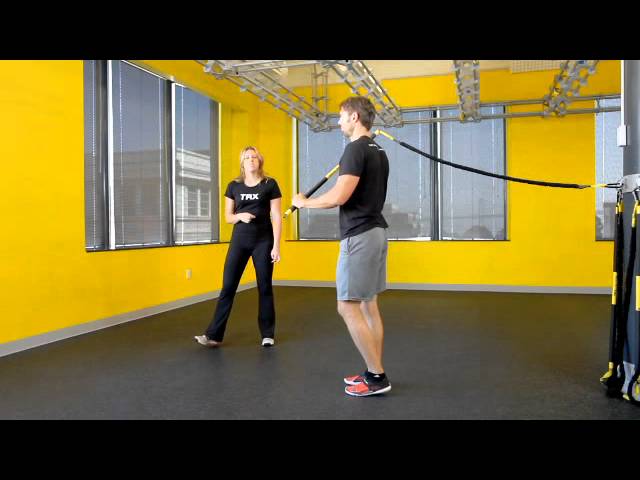
Rip Training: Metabolic Conditioning Workout
Check out this epic Rip Training metabolic blast, brought to you by TRX Programming Manager Liana Hughes and TRX Content Writer Andrew Vontz. This sweet bite-sized chipper is sure to get you sweating away that stuffing in no time. Grab your Rip Trainer and get after this total body high intensity interval workout.
One round consists of as many reps possible in 30 seconds of each of the following exercises:
Rip Lunge Press
Rip Squat Row
Rip Overhead Ax Chop
Recover for one minute and then repeat. Try to shoot for the same number of reps on both sides. One round with recovery should take you four minutes. We recommend doing three rounds, but feel free to do more or less depending on your fitness and time constraints. Remember, this is high intensity interval training, which means each round should be a short all-out effort, and the full workout should not take too much time. Get it in where you can fit it in!
Get your TRX Rip Trainer here.
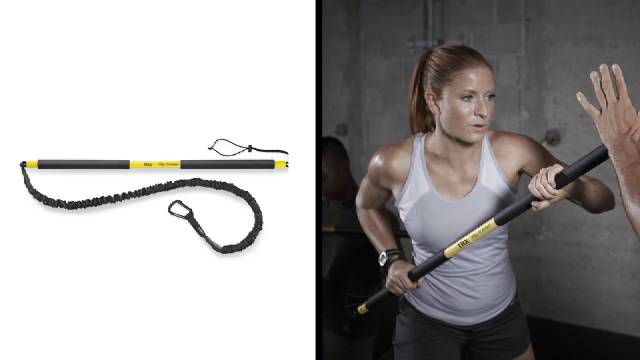
Rip Training for Wrestlers, Fighters, and Martial Artists
Wrestling coach Chad Parks tells his athletes, “In hand-to-hand combat sports, you have to be strong in weird positions.” Translation: hand-to-hand combat athletes have to be able to bend and twist their bodies and still be able to move another person’s body around, all while resisting him. With the TRX Rip Trainer, Chad and his athletes are able to incorporate “weird positions” into their strength training that simulate positions they might get into during hand-to-hand combat.
“The Rip Trainer allows us to add in a new type of strength and conditioning during our wrestling training,” says Chad. “These two workouts mesh together seamlessly.”
The Rip Trainer also allows Chad to train his athletes on another unique combination that exists in hand-to-hand combat sports: dynamic strength and static holds. In hand-to-hand combat, an athlete might explode into a dynamic throw and then have to hold a person in a static position to gain control of him. “This unique sport combination has traditionally been difficult to train from a strength and conditioning perspective,” says Chad. Outside of training a specific sporting drill, there are not a lot of options to train dynamic movements with resistance and then a static hold immediately after, all with one piece of equipment. This factor gets even harder to train when you add transverse movements into the equation.
In this video, Chad and some of his athletes from Shawnee Heights High School in Tecumseh, Kansas demonstrate some Rip Trainer movements that benefit the strength and conditioning needs of hand-to-hand combat athletes.
The Rip Trainer Punch allows an athlete to strike while experiencing resistance forces against the striking arm. This allows the athlete to work explosion with rotational resistance, while learning to rotate his hip for more power and better form.
The Rip Trainer Step Back Throw allows an athlete to feel resistance throughout a wrestling/judo style of throw. The Rip Trainer Step Back Throw also allows the athlete to complete the throwing motion with resistance while using footwork in the process. This is a complex movement and will increase a hand-to-hand combat athlete’s dynamic power in the throwing motion.
The Rip Trainer Sweep is another exercise Chad has created specifically for ground work used in Jiu Jitsu or MMA. Many times, a hand-to-hand combat athlete is on his back and trying to sweep an opponent. Many sweeps are executed with no arms or legs having any ground contact. Yet, the athlete must create enough force or transfer an opponent’s force in order to sweep him over. The Rip Trainer Sweep allows an athlete to work on creating force from his back with his limbs in the air. He also has to pull against the Rip Trainer bungee and explode through the sweeping motion. This exercise engages every core muscle and moves from a static position directly into a dynamic movement with resistance.
The Rip Trainer Chest Press, followed directly by the Rip Trainer Row, is a great combination movement that, completed in short durations at a high intensity, will test even the best conditioned athletes. For this exercise, Chad has connected both sides of the Rip Trainer to create these explosive bilateral exercises that allow his athletes to simultaneously build strength, endurance and power. He also uses the bilateral position to train leg strength and develop muscle memory for knee strikes.
“TRX has allowed me and my athletes to take our training to the next level,” says Chad. “We use the TRX Suspension Trainer and the TRX Rip Trainer at least three days per week to improve our strength and conditioning and our hand-to-hand combat sporting abilities. If you are a hand-to-hand combat athlete and haven’t added TRX to your training, you are missing out!”
For more on the TRX Rip Trainer, click here.
Chad Parks is the head wrestling coach at Shawnee Heights High School in Tecumseh, Kansas. This son of a National Hall of Fame wrestling coach has over 25 years of combined wrestling experience to include both active competition and coaching at both the college and high school levels. He instructs at wrestling clinics throughout the Midwest.
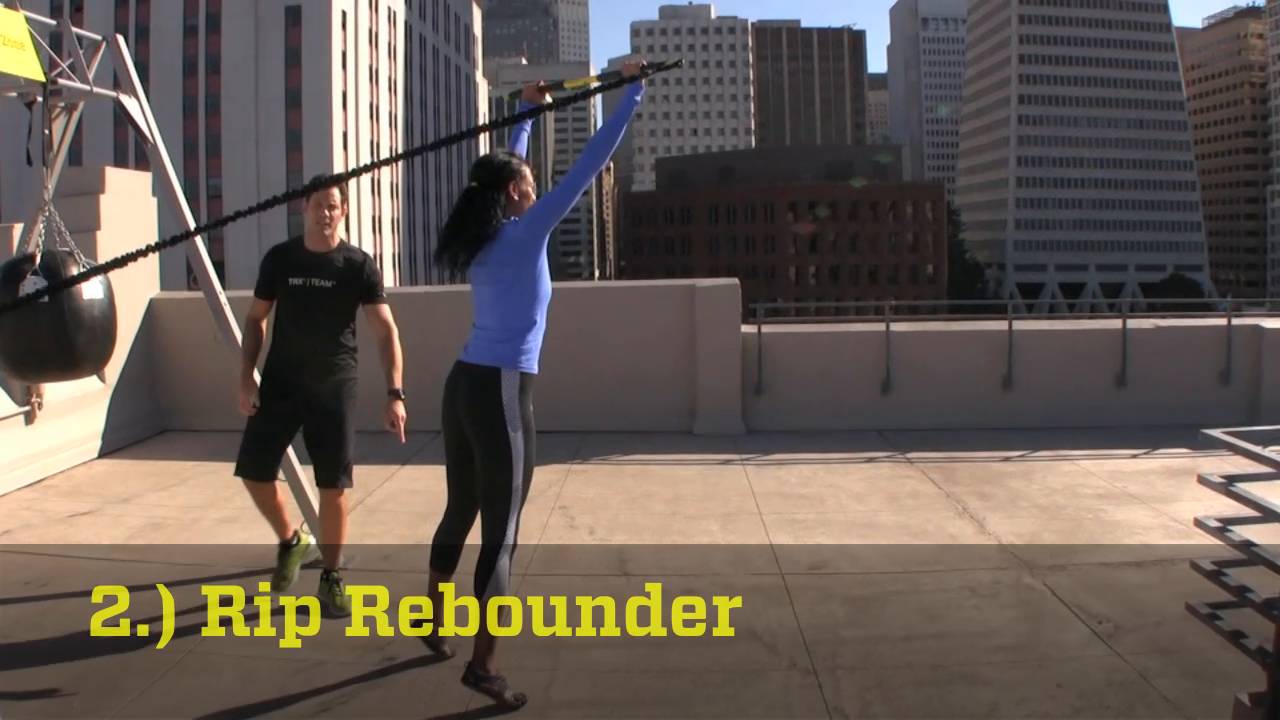
Rip Training for Basketball
Improve your basketball game with this TRX Rip Training workout from inventor of the Rip Trainer Pete Holman, as featured on Stack.
Basketball players are fast, explosive athletes–which is why so many can dunk the ball effortlessly, or quickly weave through defenders and drive to the net. The downside? Players can hurt themselves in the process. All of that jumping and changing direction takes a toll on the body.
Traditional weight room workouts can make you stronger, but they don’t necessarily make you more durable. That’s why the TRX Rip Trainer is an excellent piece of equipment to have in your training toolbox as a basketball player. Rip Trainer exercises can mirror the way your body moves on the court, making you more able to handle the demands of practices and games.
By placing an uneven load on one side of your body, the Rip Trainer adds a core strength and stability component to the moves, which can help you be stronger and more balanced on the hardwood. The added core strength makes you less likely to sustain injuries that can occur from getting knocked around, losing your balance or general wear and tear.
Try this three-exercise Rip Training workout to become a better and more durable basketball player:
Rip Lateral Step Row (10-15 reps on each side)
Rip Rebounder (10-15 reps on each side)
Rip Skater (10-15 reps on each side)
Perform 2-3 sets of each exercise.
Here is an in depth look at the specific benefits of each exercise:
Rip Lateral Step Row
This move helps you develop a low, wide base of support and core strength that’s essential for establishing your position in the paint. The Rip Trainer’s unbalanced load forces you to work on balance and stability, so opponents can't knock you off the ball or out of position. To increase the challenge, step further away from the anchor or increase cadence between reps.
Rip Rebounder
Basketball is a game of rebounds and jump shots, so your ability to get vertical can make or break your success on the court. The Rip Rebounder can help increase your jumping power, while the unbalanced load simulates being pushed and shoved when going up for a rebound, jump shot or dunk. For an increased metabolic challenge, see how many reps you can complete in 30 to 45 seconds.
Rip Skater
Ballers need the ability to decelerate and change direction quickly. These skills make you elusive on offense and enable you to provide blanket-like coverage on defense. The Rip Skater improves your change-of-direction quickness while also reinforcing your body against injuries like ankle sprains. The move also requires core strength, so keep those abs engaged throughout. For an increased challenge, extend your arms away from your chest.
If you don't yet have a TRX Rip Trainer, get yours today here.
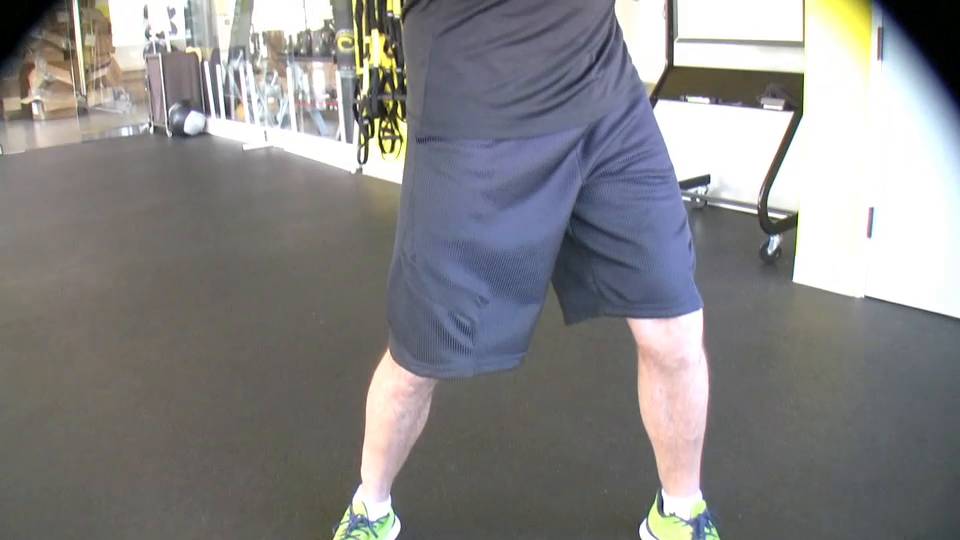
Rip Training for Baseball
Ever wonder how small baseball players like New York Yankee second baseman Dustin Ackley (190 pounds) can smash the ball out of the park? Ackley may not look physically imposing, but he has the perfect balance of strength, power, mobility and speed that is needed to forcefully swing a bat.
Regardless of how "natural" your swing is, you can develop your hitting power with proper training. The TRX Rip Trainer a piece of resistance equipment that is an ideal tool for this, because you can perform exercises that mirror swinging a bat. Training in a similar movement pattern will increase strength, power, balance, mobility and coordination in the same muscles that you use when you're at the plate.
Working these muscles with the Rip Trainer will help prevent injury. A baseball swing is a violent movement, and strong muscles on both sides help decelerate the bat and reduce stress on your body. Want more personalized training recommendations? Take our quick assessment quiz to get a customized workout plan that focuses on your specific sport and injury prevention needs.
TAKE OUR TRAINING QUIZ
So, next time you hit the weight room, grab a Rip Trainer and do the following three exercises (demonstrated in the video above). Perform them two to three times each week, 8-12 per side.
Rip StackThis exercise develops a "rock solid" core for enhanced power and durability throughout the season. Developing maximal core strength is an integral part of power production and should not be neglected.
Stand sideways to the anchor with your feet in a parallel stance
Rotate your hips, spine and shoulders as a "cylinder" away from the anchor point while holding the bar perpendicular to your body
Hold the bar at the end range for 10 seconds, rest for 3 seconds and repeat
Rip RotationThe Rip Rotation is designed to increase mobility in the ankles and hips, while activating the core. Mobility allows for increased range of motion and fluidity through multiple joints. Without proper mobility, speed is diminished and injuries are more likely to occur.
Stand sideways to the anchor with your feet in a parallel stance
Rotate your hips, spine and shoulders as a "cylinder" away from the anchor point, while holding the bar perpendicular to your body
Control the recoil allowing your "cylinder" to rotate back toward the anchor
Repeat with an aggressive concentric contraction and a slow and controlled eccentric contraction back toward the anchor
Rip Samurai Strike With Step
The final exercise in this series is a continuation of the Rip Rotation with the addition of a striking motion (a simultaneous push and pull on the bar) to accelerate the bar end and produce greater velocity. The added step is designed to maximize rear hip stability and power. Once this movement is fluid and controlled, start performing it at high speed.
Stand sideways to the anchor with your feet in a parallel stance
Rotate your hips, spine and shoulders as a "cylinder" away from the anchor point
Simultaneously push with your hand closest to the resistance cord and pull with your opposite hand
Step forward six to 12 inches with your lead leg while striking
If you've yet to purchase your TRX Rip Trainer, get it here.
This workout also appeared on STACK.com and is by Pete Holman, inventor of the TRX Rip Trainer.

Rip Training Football Workout
Football demands superior conditioning and durability. Need sport-specific training? Take our assessment quiz for a customized plan. The TRX Rip Trainer is ideal for developing essential football skills: lateral agility, explosive hip power, and core strength.
TAKE OUR TRAINING QUIZ
Training for football performance calls for much more than squats, deadlifts and bench presses. Strength and power development must be functional to carry over to the playing field.
The Rip Trainer continuously challenges the core because of its unbalanced load, forcing you to maintain a low and aggressive base of support during the exercises. This is key for battling opposing lineman, making a tackle or maintaining your balance.
The freedom of motion allowed by the Rip Trainer lets you meet challenges in the gym that simulate those you face on the field. Get game ready with the following high-intensity interval training (HIIT) workout from inventor of the Rip Trainer Pete Holman and STACK, which builds agility, power, strength and endurance.
Rip Trainer HIIT Football Workout
Perform this workout in circuit fashion two to three times per week. Do each exercise for 20 seconds with 10 seconds of rest between exercises and 60 seconds of rest once you complete the circuit on both sides. Repeat it two to three times.
Rip Lateral Shuffle PressThis exercise develops a low, wide base of support, lateral agility and pushing power. The Lateral Shuffle Press is an excellent drill for linemen, linebackers and fullbacks who have to rapidly get in position and block or shed blocks. Focus on your footwork and balance prior to moving with speed and intensity.
Stand facing away from the anchor with your feet in a wide squat stance
Shuffle laterally for six feet and stop abruptly with a "cut" step
Aggressively press the bar off your chest
Perform in the opposite direction
Rip Pitchfork with JumpThe Rip Pitchfork builds explosive hip power, which will directly improve your sprinting, jumping and tackling. Hip power is a hallmark of elite football players and something scouts watch for. Get low for this exercise and explode up into the move. Make sure to control the landing by stacking your knees over your feet and properly decelerating the bar as it moves back toward the anchor.
Stand facing the anchor with your feet in a squat stance
Hold the bar just above shoulder height
Squat down while reaching your power hand (the one closest to the rip cord) toward the anchor
While driving the bar laterally, jump up into the start position
Rip Stack to Samurai StrikeThis exercise is designed to build core strength and explosive rotational power. The washboard stomach isn't just for show; developing your core will boost your power and protect your body from injury. While holding the isometric "Stack" position, make sure to maintain perfect posture with your head up and chest tall.
Stand sideways to the anchor point with your feet in a squat stance
Hold the bar in a perpendicular position off your torso for 3 seconds
Perform a striking motion by simultaneous pushing, pulling and rotating away from the anchor
Reset and repeat

Pro Athletes Swear By The TRX Suspension Trainer
As we count down the hours to the Super Bowl, players for the Kansas City Chiefs and the Tampa Bay Buccaneers are working with their strength and conditioning coaches to ensure they are ready to take the field for the biggest game of the season. Many of those NFL players, like professional athletes across the spectrum of sports, are using the TRX SUSPENSION TRAINER in their daily workouts. Here are just a few of the types of athletes that love the TRX Straps.
Football
The grid iron’s front and center this weekend, so we’re kicking this list off with football. It’s no surprise that NFL teams keep TRX SUSPENSION TRAINERS in their practice facilities—the straps are incredibly effective for both strength training and mobility—but many players also have their own set of straps at home. In fact, as stay at home orders ramped up in 2020, many players began reaching out to TRX to request their own Suspension Trainers and small group sessions with TRX Training and Development Manager Miguel Vargas.
Golf
TRX Chief Science Officer Chris Frankel—who spent years as a trainer the PGA Tour with professional golfer Notah Begay—says the Suspension Trainer gives golfers a quick way to build in resistance training and core work with their mobility exercises. “Because of the design of the Suspension Trainer with that single anchor point, you have this 360-degree range of motion to really get your torso twisting—working through that X factor of dissociating hips from shoulders—with just the right amount of resistance in there so they can be strong.”
Frankel’s not the only one to realize the advantages golfers can gain from training with the straps. According to Golf Digest, legendary golfers like Rory McIlroy, Phil Mickelson, Jordan Spieth, and Lydia Ko have all incorporated the Suspension Trainer in their fitness routines.
Swimming
With its emphasis on non-stop core stabilization, the TRX SUSPENSION TRAINER is the ideal training partner for swimmers. Natalie Coughlin, the 12-time Olympic medalist, even packs her straps while traveling to ensure she always has what she needs to work out on the road. Coughlin’s go-to moves include TRX Rows, Alligators, Suspended Lunges, and Planks.
CrossFit
For years, professional CrossFit athlete Kari Pearce has been the Fittest American Woman and one of the top CrossFit athletes in the world. (In 2020, she placed third at the CrossFit Games.) As is typical for competitive CrossFit-ers, Pearce’s workouts are focused on heavy weights and equipment like the Assault Bike and the SkiErg, but Pearce also uses her TRX SUSPENSION TRAINER for both training and recovery.
Mixed Martial Arts
Former MMA fighter Razor Rob McCullough isn’t just a TRX fan; he even uses the TRX SUSPENSION TRAINER to train clients. MMA athletes depend on a combination of strength and conditioning work to prepare for competition, and McCullough demonstrates just how it’s done with his TRX workouts, which combine kettlebells, the Suspension Trainer, and a jump rope. Want to train like McCullough? Check out his TRX On Demand workouts!
Whether you’re training for a competition or for improved strength and mobility in everyday life, the TRX SUSPENSION TRAINER is a safe, effective, and intuitive fitness tool. And as the Chiefs and the Bucs take the field this weekend, you can be sure that the Suspension Trainer has been integral to the Super Bowl teams’ success.
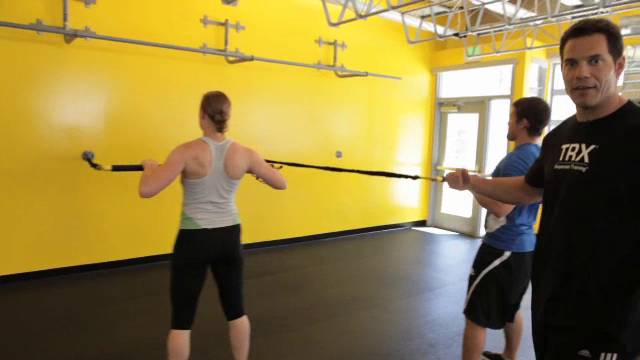
Rip Training Basic Principles
Learn how to progress and scale your TRX Rip Training workouts with TRX Director of Rip Training Pete Holman. Want to make sure you're using the right progressions for your level? Take our quick assessment quiz to get personalized recommendations for your Rip Training journey. In this video, we focus on the ability to control and produce rotational power, a unique component of Rip Training because of its utilization of asymmetrical loading and elastic resistance.
TAKE OUR TRAINING QUIZ
Rotational forces are seen in everyday life (i.e., lifting a child into a car seat) and in sports (i.e., driving a golf ball, hitting a tennis ball, etc). Depending on the task, it is necessary for the body to control rotation and maintain a neutral spine (planking) posture or produce rotation through the hips and thoracic spine. By controlling and producing rotation, we are able to mitigate the risk of injury to the back and reduce energy leaks, which helps with power transfer.
To illustrate how you can control and produce rotation on the Rip Trainer, creator Pete Holman shows us two exercises: the Rip Squat Row and the Rip Punch.
The Rip Squat Row focuses on controlling rotation in the transverse plane and emphasizes muscle recruitment in the posterior kinetic chain. This is a great exercise to help strengthen the back for activities of daily living and also targets muscles (i.e., lumbar erectors, glutes and hamstrings) that are necessary for deceleration during sport.
The Rip Punch focuses on the production of rotational force from the ground up. This exercise helps teach pivot mechanics, which is necessary for most athletes who use the hips to increase power transfer. The Rip Punch is also a move most fitness enthusiasts find aggressive, challenging and fun.
Purchase your Rip Trainer here!
Have you used the Rip Trainer in your workouts? Tell us about it below.

Preventing Low Back Pain
Ahhhh.... The trials and tribulations of back pain - perhaps the most elusive member of the “aches and pains” family. How it feels and where it comes from can vary drastically from person to person. It can be attributed to anything and everything from a singular event (like an athletic injury, a car accident, or pregnancy), to genetics, to a life of sitting all day. It can creep, linger, or strike you like a bolt of lightning. The point is, there’s a long list of types, perpetrators, symptoms, and unknowns. But the one thing we do know is that back pain is a real drag.
Fortunately, there are generic exercises for the relief and prevention of back pain - and the TRX Suspension Trainer lends itself to many of these. Not sure which exercises are right for your specific back concerns? Take our quick fitness assessment quiz to get a personalized plan that considers your current mobility and pain level.
TAKE OUR TRAINING QUIZ
Before we get started, there are a few important rules:
1. If it hurts, stop.
2. If these exercises exacerbate pain then you need to seek professional treatment.
3. Stay in "neutral spine" at all times.
What’s neutral spine?
Neutral spine is when the curves of your spine are even and form a natural “S” shape. A neutral spine is the position of vertebral alignment and the safest and most efficient posture to begin and end movement from. All the exercises outlined are designed to test your ability to move or resist moving in different directions, while maintaining a neutral spine. The greater your movement ability in neutral spine, the more you will relieve back pain and prevent it from returning.
In the image below, the first profile represents “too arched”; the second, “too flat”; and the third one is just right. (Goldilocks anyone?)
Moving on....
4 TRX EXERCISES FOR BACK PAIN:
The following TRX exercises are designed to challenge your ability to keep in neutral spine by varying the direction of movement. These exercises are suitable for any back pain. Perform this program 2-3x per week to help relieve back pain, or add it at the end of your regular routine to help prevent back pain.
Let's get started. Here's what you'll need:
TRX® PRO4 SYSTEM
BUY NOW
TRX® HOME2 SYSTEM
BUY NOW
TRX® TACTICAL GYM
BUY NOW
1. TRX Standing Plank
This exercise trains the neutral spine and sets the standard for all other exercises to follow. Set your posture from the ground up by squeezing your thighs, butt, tummy and putting your shoulder blades in your back pocket for total body tension.
Tempo: Hold for 5 seconds, rest for 5 seconds, perform for 2-3 mins. Repeat 1-2 sets. Rest 1 min between sets.
2. TRX Inverted Row
This exercise trains the all of the back muscles without putting huge pressure on the spine.
Tempo: Down for 2 seconds, up for 2 seconds, and hold for 2 seconds.Aim for 6-14 repetitions for 1-3 sets. Rest 1 min between sets.
3. TRX Resisted Rotation
This exercise activates your spinal rotation muscles without rotating your spine, and so helps you to resist rotation.
Tempo: Out for 2 seconds, hold for 2 seconds, and return for 2 seconds. Repeat 12-15 times for 1-3 sets. Rest 30 seconds between sets.
4. TRX Quadruped
This exercise trains the small stabilizing muscles of the spine.
Tempo: Move one leg to horizontal and hold for 10 seconds. Alternate each leg for 10 reps each. 1-2 sets with 1 min rest in between.
To learn more about movement based training, check out TRX Academy, a progressive curriculum based on foundational movements.
About the Author:
Ross Eathorne is an experienced Personal Trainer who has specialized in corrective exercise since 1996. Ross’ interest in rehabilitation started because he did not want a spinal stress fracture sustained at age 15 to prevent him from competing and participating in sports. Since then he has completed many specialist courses and represented New Zealand in 10 World Sports Aerobics Championships, completed several ultra marathons, outrigging races and played veterans rugby. He has developed a series of apps that emphasize quality content and programming and has authored books on topical issues such as fat loss, movement and mobility.
